United States Secretary of War
Position in the United States Cabinet from 1789 to 1947 From Wikipedia, the free encyclopedia
The secretary of war was a member of the U.S. president's Cabinet, beginning with George Washington's administration. A similar position, called either "Secretary at War" or "Secretary of War", had been appointed to serve the Congress of the Confederation under the Articles of Confederation between 1781 and 1789. Benjamin Lincoln and later Henry Knox held the position. When Washington was inaugurated as the first President under the Constitution, he appointed Knox to continue serving as Secretary of War.
| United States Secretary of War | |
|---|---|
 | |
 Flag of the secretary | |
| United States Department of War | |
| Style | Mr. Secretary |
| Type | Secretary |
| Status | Abolished |
| Member of | Cabinet |
| Reports to | President of the United States |
| Seat | Washington, D.C. |
| Appointer | The President with Senate advice and consent |
| Term length | No fixed term |
| Precursor | Secretary at War |
| Formation | September 12, 1789 |
| First holder | Henry Knox |
| Final holder | Kenneth C. Royall |
| Abolished | September 18, 1947 |
| Superseded by | Secretary of Defense Secretary of the Army Secretary of the Air Force |
| Succession | 6th in the line of succession |
The secretary of war was the head of the War Department. At first, he was responsible for all military affairs, including naval affairs. In 1798, the secretary of the Navy was created by statute, and the scope of responsibility for this office was reduced to the affairs of the United States Army. From 1886 onward, the secretary of war was in the line of succession to the presidency, after the vice president of the United States, the Speaker of the House of Representatives, the president pro tempore of the Senate and the secretary of state.
In 1947, with the passing of the National Security Act of 1947, the secretary of war was replaced by the secretary of the Army and the secretary of the Air Force, which, along with the secretary of the Navy, have since 1949 been non-Cabinet subordinates under the secretary of defense. The secretary of the Army's office is generally considered the direct successor to the secretary of war's office although the secretary of defense took the secretary of war's position in the Cabinet, and the line of succession to the presidency.
List of secretaries
Summarize
Perspective
Secretary at War (1781–1789)
The office of Secretary at War was modeled upon Great Britain's secretary at war, who was William Barrington, 2nd Viscount Barrington, at the time of the American Revolution. The office of Secretary at War was meant to replace both the commander-in-chief and the Board of War, and like the president of the board, the secretary wore no special insignia. The inspector general, quartermaster general, commissary general, and adjutant general served on the secretary's staff. However, the Army itself under Secretary Henry Knox only consisted of 700 men.
| Image | No. | Name | Home State | Start | End | Appointer |
|---|---|---|---|---|---|---|
| 1 |  |
Benjamin Lincoln | Massachusetts | March 1, 1781 | November 2, 1783 | Congress of the Confederation |
| 2 |  |
Henry Knox | Massachusetts | March 8, 1785 | September 12, 1789 |
Secretary of War (1789–1947)

- Parties
Federalist (4) Democratic-Republican (8) Democratic (14) Whig (5) Republican (25)
| No. | Image | Name | Start | End | Duration | Party | Home State | President(s) | ||
|---|---|---|---|---|---|---|---|---|---|---|
| 1 |  |
Henry Knox | September 12, 1789 | December 31, 1794 | 5 years, 110 days | Federalist | Massachusetts | George Washington (1789–1797) | ||
| 2 |  |
Timothy Pickering[1] | January 2, 1795 | December 10, 1795 | 342 days | Federalist | Pennsylvania | |||
| 3 |  |
James McHenry[2] | January 27, 1796 | June 1, 1800 | −4 years, 125 days | Federalist | Maryland | |||
| John Adams (1797–1801) | ||||||||||
| 4 | 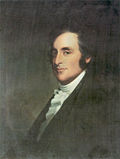 |
Samuel Dexter | June 1, 1800 | January 31, 1801 | 244 days | Federalist | Massachusetts | |||
| 5 |  |
Henry Dearborn | March 5, 1801 | March 4, 1809 | 7 years, 364 days | Democratic-Republican | Massachusetts | Thomas Jefferson (1801–1809) | ||
| 6 |  |
William Eustis | March 7, 1809 | January 13, 1813 | 3 years, 312 days | Democratic-Republican | Massachusetts | James Madison (1809–1817) | ||
| 7 | 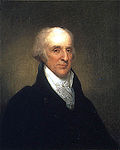 |
John Armstrong Jr. | January 13, 1813 | September 27, 1814 | 1 year, 257 days | Democratic-Republican | New York | |||
| 8 |  |
James Monroe | September 27, 1814 | March 2, 1815 | 156 days | Democratic-Republican | Virginia | |||
| 9 |  |
William H. Crawford | August 1, 1815 | October 22, 1816 | 1 year, 82 days | Democratic-Republican | Georgia | |||
| 10 |  |
John C. Calhoun | October 8, 1817 | March 4, 1825 | 7 years, 147 days | Democratic-Republican | South Carolina | James Monroe (1817–1825) | ||
| 11 |  |
James Barbour | March 7, 1825 | May 23, 1828 | 3 years, 77 days | Democratic-Republican | Virginia | John Quincy Adams (1825–1829) | ||
| 12 |  |
Peter Buell Porter | May 23, 1828 | March 9, 1829 | 290 days | Democratic-Republican | New York | |||
| 13 |  |
John Eaton | March 9, 1829 | June 18, 1831 | 2 years, 101 days | Democratic | Tennessee | Andrew Jackson (1829–1837) | ||
| 14 |  |
Lewis Cass | August 1, 1831 | October 5, 1836 | 5 years, 65 days | Democratic | Ohio | |||
| 15 |  |
Joel Roberts Poinsett | March 7, 1837 | March 4, 1841 | 3 years, 362 days | Democratic | South Carolina | Martin Van Buren (1837–1841) | ||
| 16 |  |
John Bell | March 5, 1841 | September 13, 1841 | 193 days | Whig | South Carolina | William Henry Harrison (1841) | ||
| John Tyler (1841–1845) | ||||||||||
| 17 |  |
John Canfield Spencer | October 12, 1841 | March 4, 1843 | 1 year, 143 days | Whig | New York | |||
| 18 |  |
James Madison Porter | March 8, 1843 | February 14, 1844 | 347 days | Whig | Pennsylvania | |||
| 19 |  |
William Wilkins | February 15, 1844 | March 4, 1845 | 1 year, 17 days | Democratic | Pennsylvania | |||
| 20 |  |
William Learned Marcy | March 6, 1845 | March 4, 1849 | 3 years, 363 days | Democratic | New York | James K. Polk (1845–1849) | ||
| 21 | 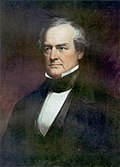 |
George W. Crawford | March 8, 1849 | July 22, 1850 | 1 year, 136 days | Whig | Georgia | Zachary Taylor (1849–1850) | ||
| 22 |  |
Charles Magill Conrad | August 15, 1850 | March 4, 1853 | 2 years, 201 days | Whig | Louisiana | Millard Fillmore (1850–1853) | ||
| 23 |  |
Jefferson Davis | March 7, 1853 | March 4, 1857 | 3 years, 362 days | Democratic | Mississippi | Franklin Pierce (1853–1857) | ||
| 24 |  |
John B. Floyd | March 6, 1857 | December 29, 1860 | 3 years, 298 days | Democratic | Virginia | James Buchanan (1857–1861) | ||
| 25 |  |
Joseph Holt | January 18, 1861 | March 4, 1861 | 45 days | Republican | Kentucky | |||
| 26 |  |
Simon Cameron | March 5, 1861 | January 14, 1862 | 315 days | Republican | Pennsylvania | Abraham Lincoln (1861–1865) | ||
| 27 |  |
Edwin M. Stanton | January 20, 1862 Suspended: August 12, 1867 – January 14, 1868[3] |
May 28, 1868 | 6 years, 129 days | Republican | Pennsylvania | |||
| Andrew Johnson (1865–1869) | ||||||||||
| – | 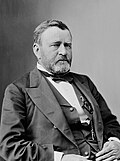 |
Ulysses S. Grant Acting[4] |
August 12, 1867 | January 14, 1868 | 155 days | Republican | Pennsylvania | |||
| 28 |  |
John McAllister Schofield | June 1, 1868 | March 13, 1869 | 285 days | Republican | Illinois | |||
| 29 |  |
John Aaron Rawlins | March 13, 1869 | September 6, 1869 | 177 days | Republican | Illinois | Ulysses S. Grant (1869–1877) | ||
| – |  |
William Sherman Acting |
September 6, 1869 | October 25, 1869 | 49 days | Republican | Ohio | |||
| 30 |  |
William W. Belknap | October 25, 1869 | March 2, 1876 | 6 years, 129 days | Republican | Iowa | |||
| 31 |  |
Alphonso Taft | March 8, 1876 | May 22, 1876 | 81 days | Republican | Ohio | |||
| 32 |  |
J. Donald Cameron | May 22, 1876 | March 4, 1877 | 286 days | Republican | Pennsylvania | |||
| 33 |  |
George W. McCrary | March 12, 1877 | December 10, 1879 | 2 years, 273 days | Republican | Iowa | Rutherford B. Hayes (1877–1881) | ||
| 34 |  |
Alexander Ramsey | December 10, 1879 | March 4, 1881 | 1 year, 84 days | Republican | Minnesota | |||
| 35 |  |
Robert Todd Lincoln | March 5, 1881 | March 4, 1885 | 3 years, 364 days | Republican | Illinois | James A. Garfield (1881) | ||
| Chester A. Arthur (1881–1885) | ||||||||||
| 36 |  |
William Crowninshield Endicott | March 5, 1885 | March 4, 1889 | 3 years, 364 days | Democratic | Massachusetts | Grover Cleveland (1885–1889) | ||
| 37 |  |
Redfield Proctor | March 5, 1889 | November 5, 1891 | 2 years, 245 days | Republican | Vermont | Benjamin Harrison (1889–1893) | ||
| 38 |  |
Stephen Benton Elkins | December 17, 1891 | March 4, 1893 | 1 year, 77 days | Republican | West Virginia | |||
| 39 |  |
Daniel S. Lamont | March 5, 1893 | March 4, 1897 | 3 years, 364 days | Democratic | New York | Grover Cleveland (1885–1889) | ||
| 40 |  |
Russell A. Alger | March 5, 1897 | August 1, 1899 | 2 years, 149 days | Republican | Michigan | William McKinley (1897–1901) | ||
| 41 |  |
Elihu Root | August 1, 1899 | January 31, 1904 | 4 years, 183 days | Republican | New York | |||
| Theodore Roosevelt (1901–1909) | ||||||||||
| 42 | 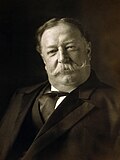 |
William Howard Taft | February 1, 1904 | June 30, 1908 | 4 years, 150 days | Republican | Ohio | |||
| 43 |  |
Luke Edward Wright | July 1, 1908 | March 4, 1909 | 246 days | Republican | Tennessee | |||
| 44 |  |
Jacob M. Dickinson | March 12, 1909 | May 21, 1911 | 2 years, 70 days | Democratic | Tennessee | William Howard Taft (1909–1913) | ||
| 45 |  |
Henry L. Stimson | May 22, 1911 | March 4, 1913 | 1 year, 286 days | Republican | New York | |||
| 46 | 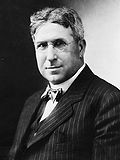 |
Lindley Miller Garrison | March 5, 1913 | February 10, 1916 | 2 years, 342 days | Democratic | New Jersey | Woodrow Wilson (1913–1921) | ||
| 47 |  |
Newton D. Baker | March 9, 1916 | March 4, 1921 | 4 years, 360 days | Democratic | Ohio | |||
| 48 |  |
John W. Weeks | March 5, 1921 | October 13, 1925 | 4 years, 223 days | Republican | Massachusetts | Warren G. Harding (1921–1923) | ||
| Calvin Coolidge (1923–1929) | ||||||||||
| 49 |  |
Dwight F. Davis | October 14, 1925 | March 4, 1929 | 3 years, 141 days | Republican | Missouri | |||
| 50 |  |
James William Good | March 6, 1929 | November 18, 1929 | 257 days | Republican | Iowa | Herbert Hoover (1929–1933) | ||
| 51 |  |
Patrick J. Hurley | December 9, 1929 | March 4, 1933 | 3 years, 85 days | Republican | Oklahoma | |||
| 52 |  |
George Dern | March 4, 1933 | August 27, 1936 | 3 years, 176 days | Democratic | Utah | Franklin D. Roosevelt (1933–1945) | ||
| 53 |  |
Harry Hines Woodring | September 25, 1936 | June 20, 1940 | 3 years, 298 days | Democratic | Kansas | |||
| 54 |  |
Henry L. Stimson | July 10, 1940 | September 21, 1945 | 5 years, 73 days | Republican | New York | |||
| Harry S. Truman (1945–1953) | ||||||||||
| 55 |  |
Robert P. Patterson | September 27, 1945 | July 18, 1947 | 1 year, 294 days | Republican | New York | |||
| 56 |  |
Kenneth Royall | July 19, 1947 | September 18, 1947 | 61 days | Democratic | North Carolina | |||
See also
References
Wikiwand - on
Seamless Wikipedia browsing. On steroids.

